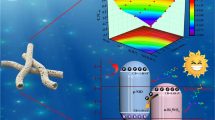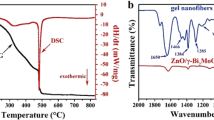Abstract
The major challenge regarding new photocatalysts is to obtain a semiconductor with high and stable photocurrent from inexpensive and abundant materials. Niobium oxide meets some of these requirements, but its photocurrent is usually very low. Therefore, this study introduces the synthesis and characterization of self-organized Nb2O5 nanotubes (Nb2O5Nt) presenting a high photocurrent density of 0.04 mA cm−2 under incidence of artificial sunlight, of 100 mW cm−2, and potential of 1.5 V without further surface modification. The best catalyst was obtained through anodization of a Nb foil at 90 V for 2 h in a one-compartment and two-electrodes cell at room temperature, using glycerol, H2O, and NH4F as the electrolyte, followed by annealing at 450 °C for 60 min. The water concentration was the most important factor to obtain the desired morphology with a good distribution of nanotube diameters, high UV absorption, low bang gap (3.2 eV) compared to the observed for the Nb2O5 semiconductor (3.4 eV), and great photocurrent density. Such properties turn the Nb2O5Nt into a promising catalyst for direct use in photochemical reactions or as a good platform yet to be combined in heterojunctions or applied for doping and decoration.
Graphical abstract








Similar content being viewed by others
Data availability
No data or code is available to readers in this submitted work.
References
Fujishima A, Honda K (1972) Electrochemical photolysis of water at a semiconductor electrode. Nature 238:37–38. https://doi.org/10.1038/238037a0
Rajeshwar K (2011) Solar energy conversion and environmental remediation using inorganic semiconductor-liquid interfaces: the road traveled and the way forward. J Phys Chem 2:1301–1309. https://doi.org/10.1021/jz200396h
Paracchino A, Laporte V, Sivula K et al (2011) Highly active oxide photocathode for photoelectrochemical water reduction. Nat Mater 10:456–461. https://doi.org/10.1038/nmat3017
Rajeshwar K, Thomas A, Janaky C (2015) Photocatalytic activity of inorganic semiconductor surfaces: myths, hype, and reality. J Phys Chem Lett 6:139–147. https://doi.org/10.1021/jz502586p
Peter LM, Wijayantha KGU (2014) Photoelectrochemical water splitting at semiconductor electrodes: fundamental problems and new perspectives. ChemPhysChem 15:1983–1995. https://doi.org/10.1002/cphc.201402024
Thomas A, Janáky C, Samu GF et al (2015) Time- and energy-efficient solution combustion synthesis of binary metal tungstate nanoparticles with enhanced photocatalytic activity. Chemsuschem 8:1652–1663. https://doi.org/10.1002/cssc.201500383
Galstyan V, Comini E, Faglia G, Sberveglieri G (2014) Synthesis of self-ordered and well-aligned Nb2O5 nanotubes. CrystEngComm 16:10273–10279. https://doi.org/10.1039/c4ce01540a
Yang M, Zhao X, Zheng S et al (2017) A new electrochemical platform for ultrasensitive detection of atrazine based on modified self-ordered Nb2O5nanotube arrays. J Electroanal Chem 791:17–22. https://doi.org/10.1016/j.jelechem.2017.03.009
Adán C, Marugán J, Sánchez E et al (2016) Understanding the effect of morphology on the photocatalytic activity of TiO2 nanotube array electrodes. Electrochim Acta 191:521–529. https://doi.org/10.1016/j.electacta.2016.01.088
Lynch RP, Ghicov A, Schmuki P (2010) A photo-electrochemical investigation of self-organized TiO2 nanotubes. J Electrochem Soc 157:G76. https://doi.org/10.1149/1.3276455
Liu J, Xue D, Li K (2011) Single-crystalline nanoporous Nb2O5 nanotubes. Nanoscale Res Lett 6:1–8. https://doi.org/10.1186/1556-276X-6-138
Wei W, Lee K, Shaw S, Schmuki P (2012) Anodic formation of high aspect ratio, self-ordered Nb2O5 nanotubes. Chem Commun 48:4244. https://doi.org/10.1039/c2cc31007d
Li X, Zhang T, Gu S et al (2013) Reduced graphene oxide/potassium niobate composite nanoscrolls with enhanced photocatalytic activity for dye degradation. Sep Purif Technol 108:139–142. https://doi.org/10.1016/j.seppur.2013.02.018
Sieber I, Hildebrand H, Friedrich A, Schmuki P (2005) Formation of self-organized niobium porous oxide on niobium. Electrochem commun 7:97–100. https://doi.org/10.1016/j.elecom.2004.11.012
Moon HG, Jang HW, Kim JS et al (2011) A route to high sensitivity and rapid response Nb2O5-based gas sensors: TiO2 doping, surface embossing, and voltage optimization. Sens Actuators B Chem 153:37–43. https://doi.org/10.1016/j.snb.2010.10.003
Yao DD, Rani RA, O’Mullane AP et al (2014) High performance electrochromic devices based on anodized nanoporous Nb2O5. J Phys Chem C 118:476–481. https://doi.org/10.1021/jp410097y
Cavalcanti RM, De Barros ICL, Diasb JA, Diasb SCL (2013) Characterization of ZSM-5 modified with niobium pentoxide: The study of thiophene adsorption. J Braz Chem Soc 24:40–50. https://doi.org/10.1590/S0103-50532013000100007
Gu Y, Liu X, Niu T, Huang J (2010) Titania nanotube/hollow sphere hybrid material: dual-template synthesis and photocatalytic property. Mater Res Bull 45:536–541. https://doi.org/10.1016/j.materresbull.2010.02.009
Suzuki S, Teshima K, Ishizaki T et al (2011) Unique three-dimensional nano-/micro-textured surfaces consisting of highly crystalline Nb2O5 nanotubes. J Cryst Growth 318:1095–1100. https://doi.org/10.1016/j.jcrysgro.2010.11.129
Knez BM, Nielsch K, Niinistö L (2007) Synthesis and surface engineering of complex nanostructures by atomic layer deposition. Adv Mater 19:3425–3438. https://doi.org/10.1002/adma.200700079
de Brito JF, Hudari FF, Zanoni MVB (2018) Photoelectrocatalytic performance of nanostructured p-n junction NtTiO2/NsCuO electrode in the selective conversion of CO2 to methanol at low bias potentials. J CO2 Util 24:81–88
de Brito JF, Perini JAL, Perathoner S, Zanoni MVB (2019) Turning carbon dioxide into fuel concomitantly to the photoanode-driven process of organic pollutant degradation by photoelectrocatalysis. Electrochim Acta 306:277–284. https://doi.org/10.1016/j.electacta.2019.03.134
Roy P, Berger S, Schmuki P (2011) TiO2 nanotubes: synthesis and applications. Angew Chem Int Ed Engl 50:2904–2939. https://doi.org/10.1002/anie.201001374
Galstyan V, Comini E, Vomiero A et al (2012) Fabrication of pure and Nb-TiO2 nanotubes and their functional properties. J Alloys Compd 536:S488–S490. https://doi.org/10.1016/j.jallcom.2011.12.076
Rao BM, Torabi A, Varghese OK (2016) Anodically grown functional oxide nanotubes and applications. MRS Commun 6:375–396. https://doi.org/10.1557/mrc.2016.46
Lee K, Yang Y, Yang M, Schmuki P (2012) Formation of highly ordered nanochannel Nb oxide by self-organizing anodization. Chem - A Eur J 18:9521–9524. https://doi.org/10.1002/chem.201201426
Fang X, Hu L, Huo K et al (2011) New Ultraviolet Photodetector Based on Individual Nb2O5 Nanobelts. Adv Funct Mater 21:3907–3915. https://doi.org/10.1002/adfm.201100743
Memari M, Memarian N (2020) Designed structure of bilayer TiO2–Nb2O5 photoanode for increasing the performance of dye-sensitized solar cells. J Mater Sci Mater Electron 31:2298–2307. https://doi.org/10.1007/s10854-019-02762-3
Qu X, Liu Y, Li B et al (2020) Nanostructured T-Nb2O5-based composite with reduced graphene oxide for improved performance lithium-ion battery anode. J Mater Sci 55:13062–13074. https://doi.org/10.1007/s10853-020-04910-1
Cui H, Zhu G, Xie Y et al (2015) Black nanostructured Nb2O5 with improved solar absorption and enhanced photoelectrochemical water splitting. J Mater Chem A 3:11830–11837. https://doi.org/10.1039/C5TA01544H
Ruff T, Hahn R, Killian MS et al (2012) Visible light photo response from N-doped anodic niobium oxide after annealing in ammonia atmosphere. Electrochim Acta 62:402–407. https://doi.org/10.1016/j.electacta.2011.12.045
Ghicov A, Schmuki P (2009) Self-ordering electrochemistry: a review on growth and functionality of TiO2 nanotubes and other self-aligned MO(x) structures. Chem Commun (Camb) 2791:808. https://doi.org/10.1039/b822726h
Cai Q, Paulose M, Varghese OK, Grimes CA (2005) The effect of electrolyte composition on the fabrication of self-organized titanium oxide nanotube arrays by anodic oxidation. J Mater Res 20:2005. https://doi.org/10.1557/JMR.2005.0020
Mor GK, Varghese OK, Paulose M et al (2011) (2006) A review on highly ordered, vertically oriented TiO2 nanotube arrays: Fabrication, material properties, and solar energy applications. Sol Energy Mater Sol Cells 90(14):2011–2075. https://doi.org/10.1016/j.solmat.2006.04.007
Parkhutik VP, Shershulsky VI (1992) Theoretical Modelling of Porous Oxide Growth on Aluminium. J Phys D Appl Phys 25:1258–1263. https://doi.org/10.1088/0022-3727/25/8/017
Stróż A, Goryczka T, Łosiewicz B (2019) Electrochemical Formation of Self-Organized Nanotubular Oxide Layers on Niobium (Review). Curr Nanosci 15:42–48. https://doi.org/10.2174/1573413714666180115141012
Roy P, Berger S, Schmuki P (2011) TiO2 nanotubes: synthesis and applications. Angew Chemie-Int Ed 50:2904–2939. https://doi.org/10.1002/anie.201001374
Jani NA, Haw CY, Chiu WS et al (2017) Understanding the effect of plasmonic enhancement on photocatalytic activity of TiO2 nanotube arrays. Mater Charact 128:134–141. https://doi.org/10.1016/j.matchar.2017.03.034
Ampelli C, Tavella F, Perathoner S, Centi G (2017) Engineering of photoanodes based on ordered TiO2-nanotube arrays in solar photo-electrocatalytic (PECa) cells. Chem Eng J 320:352–362. https://doi.org/10.1016/j.cej.2017.03.066
Prakasam HE, Shankar K, Paulose M et al (2007) A new benchmark for TIO2 nanotube array growth by anodization. J Phys Chem C 111:7235–7241
Habazaki H, Oikawa Y, Fushimi K et al (2009) Importance of water content in formation of porous anodic niobium oxide films in hot phosphate – glycerol electrolyte. Electrochim Acta 54:946–951. https://doi.org/10.1016/j.electacta.2008.08.031
Paramasivam I, Jha H, Liu N, Schmuki P (2012) A review of photocatalysis using self-organized TIO2 nanotubes and other ordered oxide nanostructures. Small 8:3073–3103. https://doi.org/10.1002/smll.201200564
Roy P, Kim D, Lee K et al (2010) TiO2 nanotubes and their application in dye-sensitized solar cells. Nanoscale 2:45–59. https://doi.org/10.1039/b9nr00131j
Corradini PG, De Brito JF, Boldrin Zanoni MV, Mascaro LH (2020) Artificial photosynthesis for alcohol and 3-C compound formation using BiVO4-lamelar catalyst. J CO Util 36:187–195. https://doi.org/10.1016/j.jcou.2019.10.020
Qi X, Zhu X, Wu J et al (2014) Controlled synthesis of BiVO4 with multiple morphologies via an ethylenediamine-assisted hydrothermal method. Mater Res Bull 59:435–441. https://doi.org/10.1016/j.materresbull.2014.08.004
Centi G, Passalacqua R, Perathoner S et al (2007) Oxide thin films based on ordered arrays of 1D nanostructure. A possible approach toward bridging material gap in catalysis. Phys Chem Chem Phys 9:4930. https://doi.org/10.1039/b703326p
de Brito JF, Tavella F, Ampelli C et al (2018) Role of CuO in the modification of the photocatalytic water splitting behavior of TiO2 nanotube thin films. Appl Catal B Environ 224:136–145. https://doi.org/10.1016/j.apcatb.2017.09.071
Bessegato GG, Cardoso JC, Da SBF, Zanoni MVB (2014) Enhanced photoabsorption properties of composites of Ti/TiO2 nanotubes decorated by Sb2S3 and improvement of degradation of hair dye. J Photochem Photobiol A Chem 276:96–103. https://doi.org/10.1016/j.jphotochem.2013.12.001
Martins AS, Lachgar A, Zanoni MVB (2020) Sandwich Nylon/stainless-steel/WO3 membrane for the photoelectrocatalytic removal of reactive red 120 dye applied in a flow reactor. Sep Purif Technol 237:116338. https://doi.org/10.1016/j.seppur.2019.116338
Sun Y, Zhao Q, Wang G, Yan K (2017) Influence of water content on the formation of TiO2 nanotubes and photoelectrochemical hydrogen generation. J Alloys Compd 711:514–520. https://doi.org/10.1016/j.jallcom.2017.03.007
Fabrao RM, de Brito JF, da Silva JL et al (2016) Appraisal of photoelectrocatalytic oxidation of glucose and production of high value chemicals on nanotube Ti/TiO2 electrode. Electrochim Acta 222:123–132. https://doi.org/10.1016/j.electacta.2016.10.164
Huang H, Wang C, Huang J et al (2014) Structure inherited synthesis of N-doped highly ordered mesoporous Nb2O5 as robust catalysts for improved visible light photoactivity. Nanoscale 6:7274–7280. https://doi.org/10.1039/c4nr00505h
Park J, Bauer S, Von Der MK, Schmuki P (2007) Nanosize and vitality: TIO2 nanotube diameter directs cell fate. Nano Lett 7:1686–1691
Yasuda K, Macak JM, Berger S et al (2007) Mechanistic aspects of the self-organization process for oxide nanotube formation on valve metals. J Electrochem Soc 154:C472–C478. https://doi.org/10.1149/1.2749091
Macak JM, Tsuchiya H, Taveira L et al (2005) Smooth anodic TIO2 nanotubes**. Angew Chem Int Ed 44:7463–7465. https://doi.org/10.1002/anie.200502781
Dumée L, Sears K, Schütz J et al (2010) A preliminary study on the effect of macro cavities formation on properties of carbon nanotube bucky-paper composites. Materials (Basel) 4:553–561. https://doi.org/10.3390/ma4030553
Shankar K, Mor GK, Prakasam HE (2007) Highly-ordered TiO2 nanotube arrays up to 220 µm in length: use in water photoelectrolysis and dye-sensitized solar cells. Nanotechnology 18:1–11. https://doi.org/10.1088/0957-4484/18/6/065707
Allam NK, Grimes CA (2008) Effect of cathode material on the morphology and photoelectrochemical properties of vertically oriented TiO2 nanotube arrays. Sol Energy Mater Sol Cells 92:1468–1475. https://doi.org/10.1016/j.solmat.2008.06.007
Acknowledgements
The authors thank the LCE/DEMa/UFSCar; CAPES; CNPq (grant # 152471/2018-9) and FAPESP (grant #2018/16401-8, #2018/02950-0, #2013/07296-2, #2014/50249-8, #2017/11986-5).
Author information
Authors and Affiliations
Corresponding authors
Ethics declarations
Conflict of interest
The authors declare that they have no conflicts of interest to this work.
Additional information
Handling Editor: Pedro Camargo.
Publisher's Note
Springer Nature remains neutral with regard to jurisdictional claims in published maps and institutional affiliations.
Rights and permissions
About this article
Cite this article
de Brito, J.F., Mascaro, L.H. Enhancement of photocurrent response for self-ordered Nb2O5 nanotubes synthesized at room temperature. J Mater Sci 56, 2088–2102 (2021). https://doi.org/10.1007/s10853-020-05317-8
Received:
Accepted:
Published:
Issue Date:
DOI: https://doi.org/10.1007/s10853-020-05317-8




